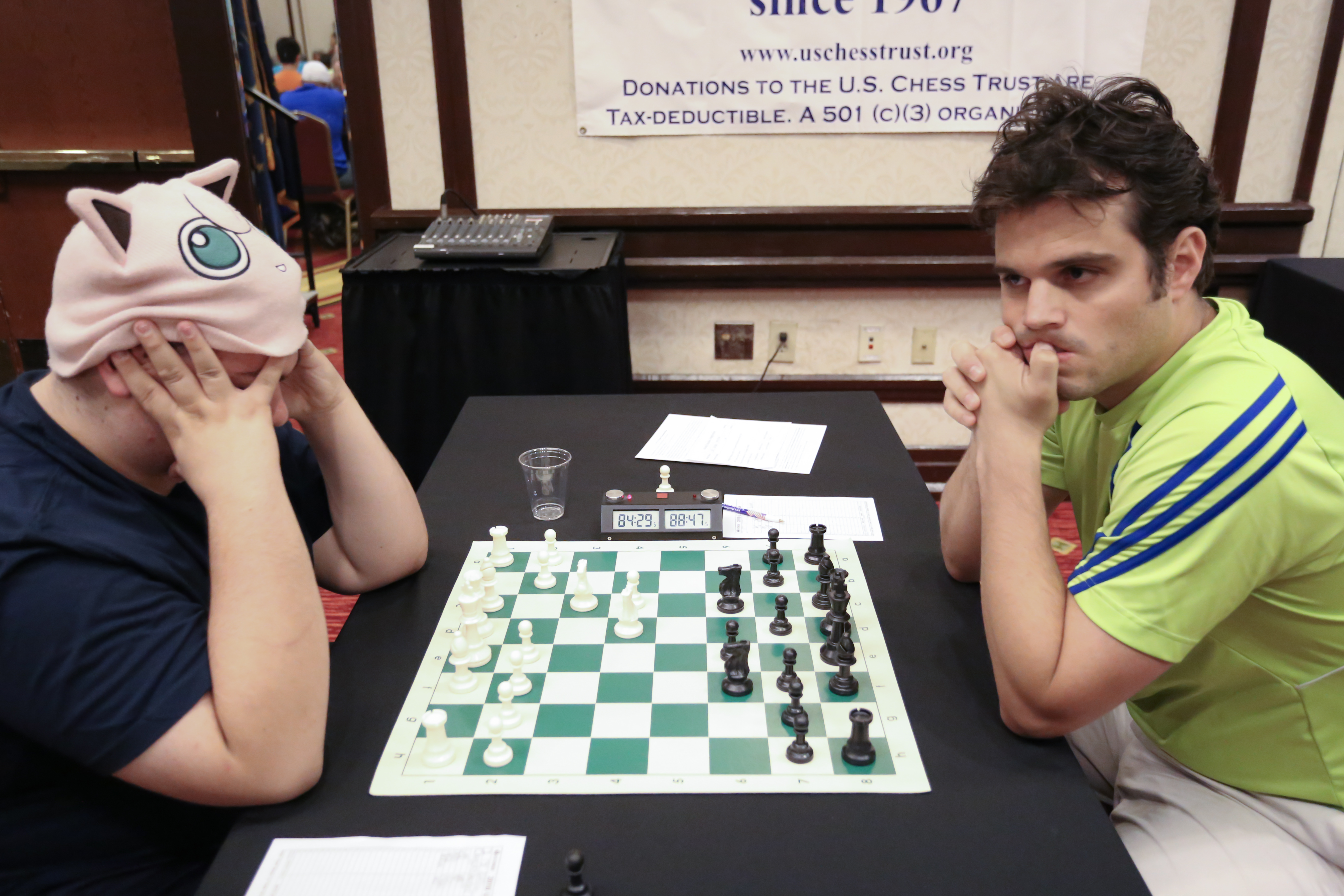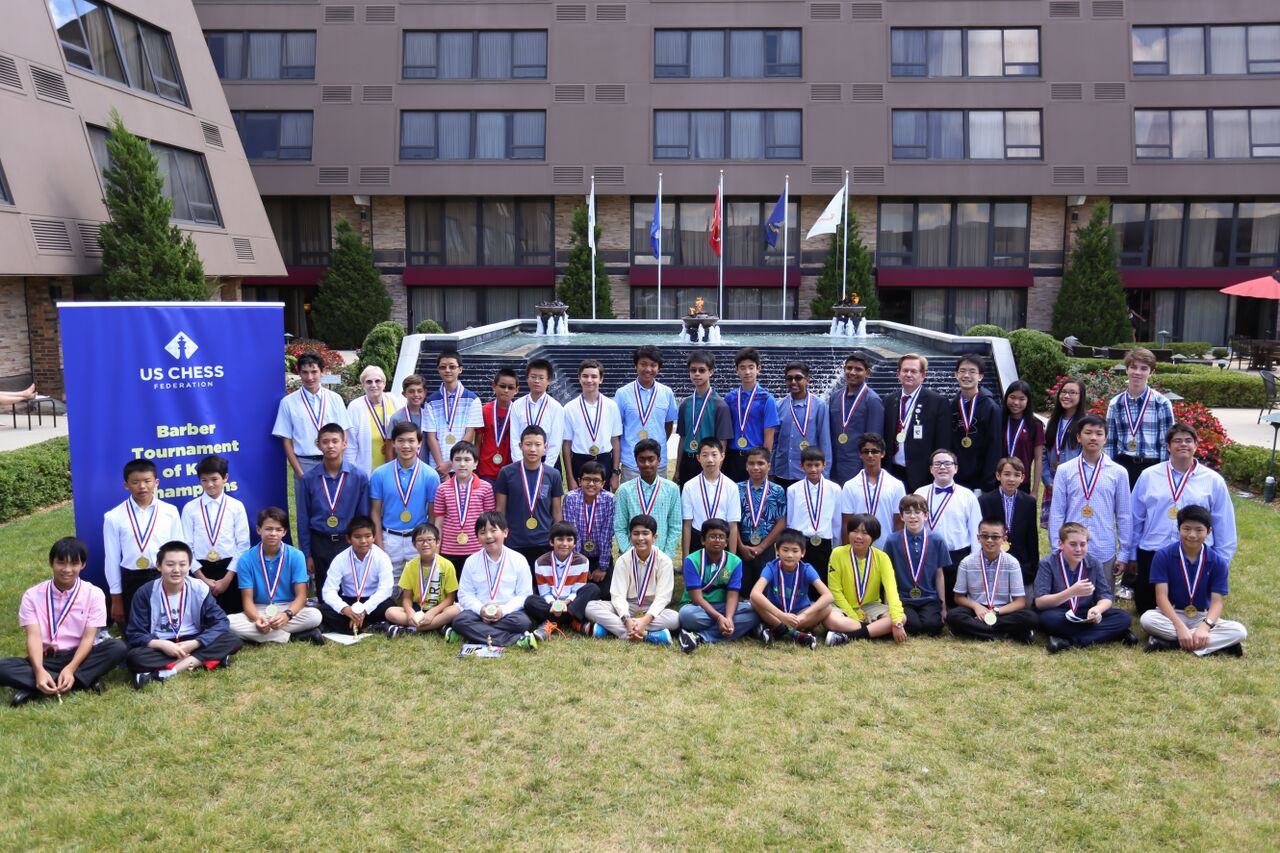 Joy Cao, Photo Anne Buskirk
Joy Cao, Photo Anne Buskirk Tiny Joy Cao delivered a big-voice, a cappella rendition of the National Anthem to begin US Open festivities in Indianapolis, rousing the Saturday afternoon crowd that packed the Parade of Champions ceremony at the opening of the Denker tournament of high school champions, Barber tournament of K-8 Champions, and National Girls Tournament of Champions (NGTOC). The audience applauded a welcome to the 139 state affiliate representatives vying for three $5,000 college scholarships, among other awards. Joy herself is the NGTOC representative from Massachusetts.
 Maureen Grimaud, chair of US Chess's Women's committee, making the first move for NGTOC
Maureen Grimaud, chair of US Chess's Women's committee, making the first move for NGTOCThese three junior championships are separate events from the main event, the US Open. The young champions, among them a record-setting 30 master players, maintained their three separate sections but joined the 134 US Open competitors who took the track for the first lap in the traditional, nine-day schedule—one game per night at 7 p.m.—in the Marriott Indianapolis East ballroom. The event may be the chess equivalent of the famous 500-mile auto race held annually a dozen miles away, but the US Open offers a number of different paces. Today’s competitors will be joined by waves of players on Tuesday, when the junior champs finish up, and on Thursday. These later-comers, choosing a six-day or even a four-day schedule, will all eventually play the same number of rounds, nine, but at a far more hectic pace to catch up. All of them join one united section in round 7 Thursday night, everyone chasing part of the $50,000 total prize fund.
 College chair and Managing Director of the US Chess Trust Al Lawrence speaking during the Barber, Denker and NGTOC Opening Ceremony, Photo Anne Buskirk
College chair and Managing Director of the US Chess Trust Al Lawrence speaking during the Barber, Denker and NGTOC Opening Ceremony, Photo Anne Buskirk Fidel Corrales Jimenez, Missouri, and Alex Fishbein, Colorado, are the only grandmasters choosing the slow-paced traditional schedule, but they’re sure to be joined by high-powered colleagues. Fishbein won the first Denker Tournament of HS Champions back in 1985.
 Black vs. Corrales in round one of the US Open, Photo Anne Buskirk
Black vs. Corrales in round one of the US Open, Photo Anne Buskirk Corrales, who recently graduated with a bachelor’s degree in MIS from Webster University, definitely prefers the traditional pace. “One game a day is enough,” he said. “Three games—wow, that’s too much!” Coralles backed up his choice with a beautiful center-of-the-board mating attack in round one.
[pgn] [Event "US Open"] [Site "?"] [Date "2016.07.31"] [Round "?"] [White "Black, Clancey"] [Black "Corrales Jimenez, Fidel"] [Result "0-1"] [ECO "B44"] [WhiteElo "1812"] [BlackElo "2598"] [Annotator "Lawrence,Al"] [PlyCount "40"] [EventDate "2016.??.??"] [SourceDate "2016.07.31"] 1. d4 Nf6 2. c4 e6 3. Nf3 c5 4. Nc3 cxd4 5. Nxd4 Nc6 6. Nxc6 bxc6 7. e4 Bb4 8. e5 Ne4 9. Qg4 Nxc3 10. Qxg7 Ne4+ 11. Ke2 Rf8 12. f3 Qh4 13. Be3 (13. fxe4 Qxe4+ 14. Kd1 Ba6) 13... Ba6 14. Rc1 Bxc4+ 15. Rxc4 Qe1+ 16. Kd3 Nf2+ 17. Bxf2 Qd2+ 18. Ke4 d5+ 19. exd6 f5+ 20. Ke5 Qxd6# 0-1[/pgn]The gathering also features lots of one-day side events for those with less time, as well as workshops beginning Wednesday and the Annual Delegates’ Meeting over the final weekend. All the events are sanctioned by US Chess. Printed and electronic game bulletins are available for purchase as low as $10 for the whole event. To subscribe, email Frank Niro at [email protected].
 The $5,000 scholarship awarded at the Denker Tournament of High School Champions is provided by the US Chess Trust. The $5,000 scholarship given to the winner of the Barber Tournament of K-8 Champions is donated by Dewain Barber, the catalyst who has nurtured the annual junior champions since initiating them in 1985. The $5,000 scholarship that comes with first place in the National Girls Tournament of Champions is this year donated by Richard and Barbara Schiffrin.
The $5,000 scholarship awarded at the Denker Tournament of High School Champions is provided by the US Chess Trust. The $5,000 scholarship given to the winner of the Barber Tournament of K-8 Champions is donated by Dewain Barber, the catalyst who has nurtured the annual junior champions since initiating them in 1985. The $5,000 scholarship that comes with first place in the National Girls Tournament of Champions is this year donated by Richard and Barbara Schiffrin.  This year all 139 junior champions were issued The Dewain Barber Play It Forward Challenge, invoking each competitor to teach 100 others to play chess in the next 12 months, whether the lessons are personal, in groups, or by video. Those who complete the challenge will be recognized online and at next year’s events. “We need to start developing junior chess from the ground up, using lots of peer teaching and peer inspiration,” Barber said. “Next year we could have 13,900 more kids playing—and they could in turn teach many more.”
This year all 139 junior champions were issued The Dewain Barber Play It Forward Challenge, invoking each competitor to teach 100 others to play chess in the next 12 months, whether the lessons are personal, in groups, or by video. Those who complete the challenge will be recognized online and at next year’s events. “We need to start developing junior chess from the ground up, using lots of peer teaching and peer inspiration,” Barber said. “Next year we could have 13,900 more kids playing—and they could in turn teach many more.”
 Barber Tournament of K-8 Champs, Photo Anne Buskirk
Barber Tournament of K-8 Champs, Photo Anne BuskirkThat could give Joy Cao and the rest of us even more to sing about. Follow the tournament standings, pairings and results here on the US Open page. Also follow live updates starting from Pete Karigianis on our facebook and twitter accounts, and get involved using the hashtag #USChessOpen.
Categories
Archives
- January 2026 (8)
- December 2025 (27)
- November 2025 (29)
- October 2025 (39)
- September 2025 (27)
- August 2025 (29)
- July 2025 (43)
- June 2025 (25)
- May 2025 (24)
- April 2025 (29)
- March 2025 (29)
- February 2025 (20)
- January 2025 (24)
- December 2024 (34)
- November 2024 (18)
- October 2024 (35)
- September 2024 (23)
- August 2024 (27)
- July 2024 (44)
- June 2024 (27)
- May 2024 (31)
- April 2024 (51)
- March 2024 (34)
- February 2024 (25)
- January 2024 (26)
- December 2023 (29)
- November 2023 (26)
- October 2023 (37)
- September 2023 (27)
- August 2023 (37)
- July 2023 (47)
- June 2023 (33)
- May 2023 (37)
- April 2023 (45)
- March 2023 (37)
- February 2023 (28)
- January 2023 (31)
- December 2022 (23)
- November 2022 (32)
- October 2022 (31)
- September 2022 (19)
- August 2022 (39)
- July 2022 (32)
- June 2022 (35)
- May 2022 (21)
- April 2022 (31)
- March 2022 (33)
- February 2022 (21)
- January 2022 (27)
- December 2021 (36)
- November 2021 (34)
- October 2021 (25)
- September 2021 (25)
- August 2021 (41)
- July 2021 (36)
- June 2021 (29)
- May 2021 (29)
- April 2021 (31)
- March 2021 (33)
- February 2021 (28)
- January 2021 (29)
- December 2020 (38)
- November 2020 (40)
- October 2020 (41)
- September 2020 (35)
- August 2020 (38)
- July 2020 (36)
- June 2020 (46)
- May 2020 (42)
- April 2020 (37)
- March 2020 (60)
- February 2020 (38)
- January 2020 (45)
- December 2019 (34)
- November 2019 (35)
- October 2019 (42)
- September 2019 (45)
- August 2019 (56)
- July 2019 (44)
- June 2019 (35)
- May 2019 (40)
- April 2019 (48)
- March 2019 (61)
- February 2019 (39)
- January 2019 (30)
- December 2018 (29)
- November 2018 (51)
- October 2018 (45)
- September 2018 (29)
- August 2018 (49)
- July 2018 (35)
- June 2018 (31)
- May 2018 (39)
- April 2018 (31)
- March 2018 (26)
- February 2018 (33)
- January 2018 (30)
- December 2017 (26)
- November 2017 (24)
- October 2017 (30)
- September 2017 (30)
- August 2017 (31)
- July 2017 (28)
- June 2017 (32)
- May 2017 (26)
- April 2017 (37)
- March 2017 (28)
- February 2017 (30)
- January 2017 (27)
- December 2016 (29)
- November 2016 (24)
- October 2016 (32)
- September 2016 (31)
- August 2016 (27)
- July 2016 (24)
- June 2016 (26)
- May 2016 (19)
- April 2016 (30)
- March 2016 (36)
- February 2016 (28)
- January 2016 (32)
- December 2015 (26)
- November 2015 (23)
- October 2015 (16)
- September 2015 (28)
- August 2015 (28)
- July 2015 (6)
- June 2015 (1)
- May 2015 (2)
- April 2015 (1)
- February 2015 (3)
- January 2015 (1)
- December 2014 (1)
- July 2010 (1)
- October 1991 (1)
- August 1989 (1)
- January 1988 (1)
- December 1983 (1)







